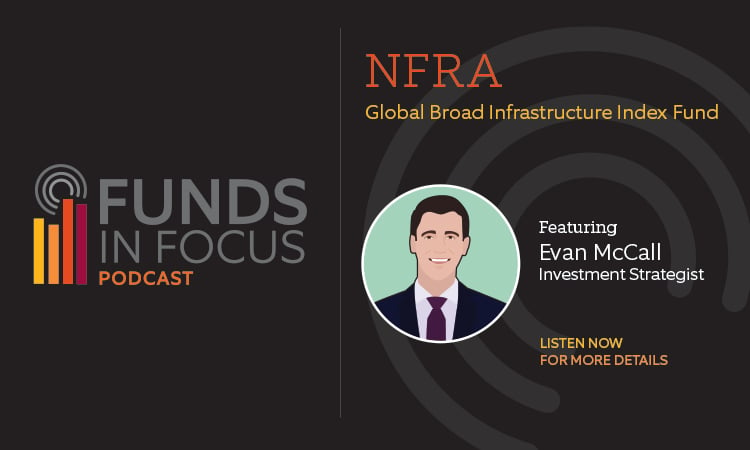The market turbulence triggered by the COVID-19 pandemic has been significant and far-reaching—but how has a traditionally defensive asset class like global listed infrastructure weathered the storm?
On a recent episode of our Funds in Focus podcast, we spoke with Investment Strategist Evan McCall about how global listed infrastructure has held up during the turmoil of the COVID-19 pandemic. Looking back at the eye of the storm in the first and second quarters of 2020, Evan shared three key takeaways on how global listed infrastructure fared.
In this episode, you'll learn
- What attracts investors to infrastructure investments
- Which two infrastructure-related structures have had significantly negative performances
- How market participants are reacting to the stream of new information about COVID-19
- How infrastructure industries performed during the first and second quarter of 2020
- What kinds of developments Evan expects to see from contemporary sectors going forward
#1: THE MARKET DOWNTURN WAS ASSET CLASS AGNOSTIC
The onset of the pandemic in the first quarter of 2020 roiled global markets—and the downturn didn’t discriminate based on asset class or region. Equity returns across domestic, developed, and emerging markets plummeted more than 20% for the quarter. And real assets—including infrastructure—posted similarly abysmal returns.
While the negative impact of COVID-19 was widespread across asset classes in the first quarter, some sectors were hit particularly hard. Among these were energy and transportation, as global lockdowns resulted in considerably slowed consumer demand and travel. As these are two key sectors comprising global infrastructure investments, they were a significant drag on performance for the asset class.
#2: INFRASTRUCTURE INDEX CHOICE MATTERS
When it comes to global listed infrastructure, there are two types of indices: legacy and contemporary. Legacy indices use a top-down approach to identify infrastructure companies using GICS sector classification codes, while contemporary indices leverage advancements in data availability and application to implement a bottom-up approach. Applying this data allows investment managers to tie company revenues to the specific infrastructure-related assets that the company owns.
These varying methodologies result in markedly different index compositions. The techniques applied for contemporary index construction can lead to greater diversification across sectors relative to legacy indices. In the case of global listed infrastructure, legacy index construction has resulted in higher concentrations in the energy and utility sectors. Conversely, the contemporary index bottom-up approach broadens the indices to include telecommunications and other companies that own assets like data centers and wireless towers.
During the first two quarters of 2020, these key differences in sector composition resulted in considerably different performance outcomes between the two types of indices. The broader contemporary infrastructure indices outperformed relative to a legacy approach over the first quarter of 2020. While this trend did reverse in the second quarter—due to communications and transportation underperformance—we’ve observed that the contemporary index balanced approach to infrastructure has proven beneficial over time.
#3: THE CASE FOR GLOBAL INFRASTRUCTURE IS ENDURING
Amidst the market turmoil of 2020, investors’ reasons for allocating to global listed infrastructure held steady. Investors continue to be attracted to infrastructure due to its potential for portfolio diversification, stable cash flows, and a long-term inflation hedge.
Looking ahead, the case for infrastructure could perhaps be strengthened by the COVID-19 pandemic. Widespread quarantines have given rise to a greater need for connectivity, which could be a boost for telecommunications companies classified as infrastructure under contemporary index methodology. And as companies start to reassess their supply chain vulnerability to pandemic risks, infrastructure investment may increase. Further, infrastructure could be poised for direct fiscal stimulus as governments shape policy to support economic recovery.
Please see our FlexShares STOXX® Global Broad Infrastructure Index Fund (NFRA) for more information on our global listed infrastructure ETF that tracks a contemporary global infrastructure index.
IMPORTANT INFORMATION
FlexShares STOXX® Global Broad Infrastructure Index Fund is subject to infrastructure-related companies risk and MLP risk. Risks associated with infrastructure-related companies include: realized revenue volume may be significantly lower than projected and/or there will be costs overruns; infrastructure project sponsors will alter their terms making a project no longer economical; macroeconomic factors such as low gross domestic product ("GDP") growth or high nominal interest rates will raise the average cost of infrastructure funding; government regulation may affect rates charged to infrastructure customers; government budgetary constraints will impact infrastructure projects; and special tariffs will be imposed.

